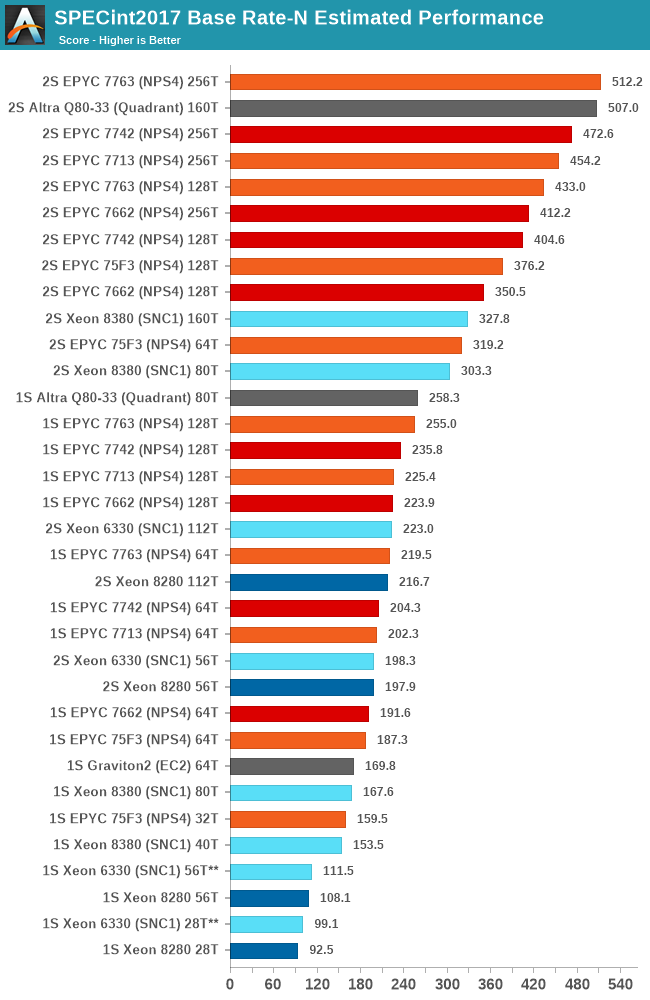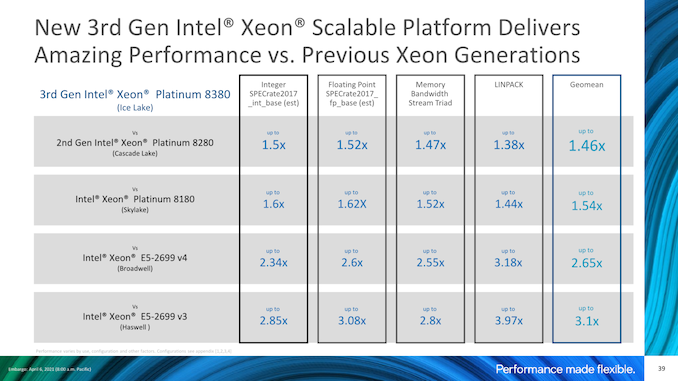Intel 3rd Gen Xeon Scalable (Ice Lake SP) Review: Generationally Big, Competitively Small
by Andrei Frumusanu on April 6, 2021 11:00 AM EST- Posted in
- Servers
- CPUs
- Intel
- Xeon
- Enterprise
- Xeon Scalable
- Ice Lake-SP
SPEC - Multi-Threaded Performance
Picking up from the power efficiency discussion, let’s dive directly into the multi-threaded SPEC results. As usual, because these are not officially submitted scores to SPEC, we’re labelling the results as “estimates” as per the SPEC rules and license.
We compile the binaries with GCC 10.2 on their respective platforms, with simple -Ofast optimisation flags and relevant architecture and machine tuning flags (-march/-mtune=Neoverse-n1 ; -march/-mtune=skylake-avx512 ; -march/-mtune=znver2 (for Zen3 as well due to GCC 10.2 not having znver3).
The new Ice Lake SP parts are using the -march/-mtune=icelake-server target. It’s to be noted that I briefly tested the system with the Skylake binaries, with little differences within margin of error.
I’m limiting the detailed comparison data to the flagship SKUs, to indicate peak performance of each platform. For that reason it’s not exactly as much an architectural comparison as it’s more of a top SKU comparison.

To not large surprise, the Xeon 8380 is posting very impressive performance advancements compared to the Xeon 8280, with large increases across the board for all workloads. The geo-mean increase is +54% with a low of +40% up to a high of +71%.
It’s to be noted that while the new Ice Lake system is a major generational boost, it’s nowhere near enough to catch up with the performance of the AMD Milan or Rome, or Ampere’s Altra when it comes to total throughput.

Looking at the FP suite, we have more workloads that are purely memory performance bound, and the Ice Lake Xeon 8380 again is posting significant performance increases compared to its predecessor, with a geo-mean of +53% with a range of +41% to +64%.
In some of the workloads, the new Xeon now catches up and is on par with AMD’s EPYC 7763 due to the fact that both systems have the same memory configuration with 8-channel DDR4-3200.
In any other workloads that requires more CPU compute power, the Xeon doesn’t hold up nearly as well, falling behind the competition by significant margins.

In the aggregate geomean scores, we’re seeing again that the new Xeon 8380 allows Intel to significantly reposition itself in the performance charts. Unfortunately, this is only enough to match the lower core count SKUs from the competition, as AMD and Ampere are still well ahead by massive leads – although admittedly the gap isn’t as embarrassing as it was before.

In the floating-point suite, the results are a bit more in favour for the Xeon 8380 compared to the integer suite, as the memory performance is weighed more into the total contribution of the total performance. It’s still not enough to beat the AMD and Ampere parts, but it’s much more competitive than it was before.
The Xeon 6330 is showcasing minor performance improvements over the 8280 and its cheaper equivalent the 6258R, but at least comes at half the cost – so while performance isn’t very impressive, the performance / $ might be more competitive.
Our performance results match Intel’s own marketing materials when it comes to the generational gains, actually even surpassing Intel’s figures by a few percent.
If you would be looking at Intel’s slide above, you could be extremely enthusiastic about Intel’s new generation, as indeed the performance improvements are extremely large compared to a Cascade Lake system.
As impressive as those generational numbers are, they really only help to somewhat narrow the Grand Canyon sized competitive performance gap we’ve had to date, and the 40-core Xeon 8380 still loses out to a 32-core Milan, and from a performance / price comparison, even a premium 75F3 costs 40% less than the Xeon 8380. Lower SKUs in the Ice Lake line-up would probably fare better in perf/$, however would also just lower the performance to an even worse competitive positioning.











169 Comments
View All Comments
Oxford Guy - Sunday, April 11, 2021 - link
'The faulty logic I see is that you seem to believe it's the review's job to...''I think it could be appropriate to do that sort of thing, in articles that...'
Don't contradict yourself or anything.
If you're not interested in knowing how fast a CPU is that's ... well... I don't know.
Telling people to go for marketing info (which is inherently deceptive — the entire fundamental reason for marketing departments to exist) is obviously silly.
mode_13h - Monday, April 12, 2021 - link
> Don't contradict yourself or anything.I think the point of confusion is that I'm drawing a distinction between the initial product review and subsequent follow-up articles they often publish to examine specific points of interest. This would also allow for more time to do a more thorough investigation, since the initial reviews tend to be conducted under strict deadlines.
> If you're not interested in knowing how fast a CPU is that's ... well... I don't know.
There's often a distinction between the performance, as users are most likely to experience it, and the full capabilities of the product. I actually want to know both, but I think the former should be the (initial) priority.
ballsystemlord - Thursday, April 8, 2021 - link
Spelling and grammar errors (there are a lot!):"At the same time, we have also spent time a dual Xeon Gold 6330 system from Supermicro, which has two 28-core processors,..."
Nonsensical English: "time a duel". I haven't the faintest what you were trying to say.
"DRAM latencies here are reduced by 1.7ns, which isn't very much a significant difference,..."
Either use "very much", or use "a significant":
DRAM latencies here are reduced by 1.7ns, which isn't a very significant difference,..."
"Inspecting Intel's prior disclosures about Ice Lake SP in last year's HotChips presentations, one point sticks out, and that's is the "SpecI2M optimisation" where the system is able to convert traditional RFO (Read for ownership) memory operations into another mechanism"
Excess "is":
"Inspecting Intel's prior disclosures about Ice Lake SP in last year's HotChips presentations, one point sticks out, and that's the "SpecI2M optimisation" where the system is able to convert traditional RFO (Read for ownership) memory operations into another mechanism"
"It's a bit unfortunate that system vendors have ended up publishing STREAM results with hyper optimised binaries that are compiled with non-temporal instructions from the get-go, as for example we would not have seen this new mechanism on Ice Lake SP with them"
You need to rewrite the sentance or add more commas to break it up:
"It's a bit unfortunate that system vendors have ended up publishing STREAM results with hyper optimised binaries that are compiled with non-temporal instructions from the get-go, as, for example, we would not have seen this new mechanism on Ice Lake SP with them"
"The latter STREAM results were really great to see as I view is a true design innovation that will benefit a lot of workloads."
Exchange "is" for "this as":
"The latter STREAM results were really great to see as I view this as a true design innovation that will benefit a lot of workloads."
Or discard "view" and rewrite as a diffinitive instead of as an opinion:
"The latter STREAM results were really great to see as this is a true design innovation that will benefit a lot of workloads."
"Intel's new Ice Lake SP system, similarly to the predecessor Cascade Lake SP system, appear to be very efficient at full system idle,..."
Missing "s":
"Intel's new Ice Lake SP system, similarly to the predecessor Cascade Lake SP system, appears to be very efficient at full system idle,..."
"...the new Ice Lake part to most of the time beat the Cascade Lake part,..."
"to" doesn't belong. Rewrite:
"...the new Ice Lake part can beat the Cascade Lake part most of the time,..."
"...both showcasing figures that are still 25 and 15% ahead of the Xeon 8380."
Missing "%":
"...both showcasing figures that are still 25% and 15% ahead of the Xeon 8380."
"Intel had been pushing very hard the software optimisation side of things,..."
Poor sentance structure:
"Intel had been pushing the software optimisation side very hard,..."
"...which unfortunately didn't have enough time to cover for this piece."
Missing "we":
"...which unfortunately we didn't have enough time to cover for this piece."
"While we are exalted to finally see Ice lake SP reach the market,..."
"excited" not "exalted":
"While we are excited to finally see Ice lake SP reach the market,..."
Thanks for the article!
Oxford Guy - Sunday, April 11, 2021 - link
Perhaps Purch would be willing to take you on as a volunteer unpaid intern for proofreading for spelling and grammar?I would think there are people out there who would do it for resume building. So... if it bothers you perhaps you should make an inquiry.
evilpaul666 - Saturday, April 10, 2021 - link
Are the W-1300s going to use 10nm this year?mode_13h - Saturday, April 10, 2021 - link
You mean the bottom-tier Xeons? Those are just mainstream desktop chips with less features disabled, so that question depends on when Alder Lake hits.I'd say "no", because the Xeon versions typically lag the corresponding mainstream chips by a few months. So, if Alder Lake launches in November, then maybe we get the Xeons in February-March of next year.
The more immediate question is whether they'll release a Xeon version of Rocket Lake. I think that's likely, since they skipped Comet Lake and there are significant platform enhancements for Rocket Lake.
AdrianBc - Monday, April 12, 2021 - link
No, the W-1300 Xeons will be Rocket Lake. The top model will be Xeon W-1390P, which will be equivalent to the top i9 Rocket Lake, with 125 W TDP and 5.3 GHz maximum turbo.rahvin - Tuesday, April 20, 2021 - link
Andre does some of the best server reviews available, IMO.KKK11 - Tuesday, May 11, 2021 - link
That is a curious-looking wafer. I thought it was fake at first but then I noticed the alignment notch. Actually, I'm still not convinced it's real because I have seen lots and lots of wafers in various stages of production and I have never seen one where partial chips go all the way out to the edges. It's a waste of time to deal with those in the steppers so no one does that.